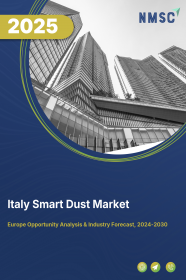
Italy Smart Dust Market by Component (Sensors, Active Optical Transmission, Passive Optical Transmission, Optical Receiver, Analog I/O, Signal Processing, Control Circuitry, Power Source, and Others), by Manufacturing Process (3D Printing and Microfabrication), by Type (Biodegradable and Non-Biodegradable) and Others– Opportunity Analysis and Industry Forecast 2026-2030
Industry: Semiconductor & Electronics | Publish Date: 14-Feb-2025 | No of Pages: 127 | No. of Tables: 93 | No. of Figures: 58 | Format: PDF | Report Code : SE1914
US Tariff Impact on Italy Smart Dust Market
Trump Tariffs Are Reshaping Global Business
Market Definition
The Italy Smart Dust Market will value at USD 5.0 million in 2025 and is predicted to reach USD 12.3 million by 2030, at a CAGR of 17.3% from 2026 to 2030. Cutting-edge technology today emphasizes miniaturization and automation. Computing history has witnessed increased connectivity, shrinking device sizes, and enhanced global communication. The growing popularity of smaller devices such as mobile phones and handheld computers, along with advancements in micro sensors and transistors, has significantly driven the development of nano computing.
Consequently, increased environmental interaction and the rise of small computing elements present opportunities to redefine interactions between computers, humans, and the environment. These trends have led to the emergence of Smart Dust, consisting of various microelectromechanical systems (MEMS), including sensors capable of detecting light, temperature, magnetism, vibration, or chemicals. Typical Smart Dust incorporates nano-structured silicon sensors that autonomously orient, sense, assemble, and report environmental data.
Industrial Monitoring Capabilities of Smart Dust is Expected to Increase its Adoption in Italy
The industrial monitoring capabilities of smart dust in the country are poised to significantly enhance its adoption in the forthcoming years. With its tiny size and wireless connectivity, smart dust sensors can be deployed across industrial settings to collect real-time data on various parameters such as temperature, pressure, and vibration. This information facilitates proactive maintenance, improves operational efficiency, and reduces downtime, resulting in cost savings and heightened productivity for industries. Furthermore, the scalability and versatility of smart dust technology make it adaptable to a diverse array of industrial applications, ranging from manufacturing plants to oil and gas facilities. As industries increasingly realize the significance of data-driven insights for optimizing operations and ensuring regulatory compliance, the demand for smart dust solutions is anticipated to surge, propelling its widespread adoption.
Integration of Smart Dust in the Medical Sector is Expected to Drive the Italy Market in the Coming Years
The incorporation of smart dust into the medical sector is set to revolutionize healthcare practices in the country in the foreseeable future. With its small size and wireless connectivity, smart dust sensors can be deployed within the human body to monitor various vital signs, detect early indications of illness, and even deliver targeted treatments. This technology enables real-time data collection, leading to more precise diagnoses and personalized medical interventions. Additionally, the continuous monitoring enabled by smart dust enhances preventive care and enables timely interventions, ultimately improving patient outcomes and reducing healthcare costs. Consequently, the adoption of smart dust in the medical field is anticipated to fuel significant growth in the smart particle market as healthcare providers increasingly acknowledge its potential to revolutionize healthcare service delivery.
Privacy Concerns Associated with Smart Dust Hinders the Italy Market Growth
Privacy concerns associated with smart dust pose a notable barrier to market growth in the country. Despite its groundbreaking capabilities for data collection and analysis, the continuous monitoring it enables raises concerns about individual privacy and data security. User express anxieties about unauthorized access to sensitive data gathered by smart dust sensors and the potential for covert surveillance. These apprehensions are exacerbated by the widespread deployment of smart dust, prompting inquiries into consent and management of personal information. Consequently, individuals, enterprises, and regulatory authorities hesitate to fully adopt smart dust technology, impeding its market growth while seeking effective strategies to tackle these privacy issues.
Introduction of Smart Dust in Space Research is Expected to Create Ample Opportunities in the Italy Market
Smart dust is expected to have a significant role in upcoming space missions in the country. Nanosensors greatly enhance high-performance materials or highly efficient propulsion systems. Smart dust sensors could be placed in space or on the surface of a terrestrial planet where traditional detection systems would be impractical or difficult to install. Different international space exploration organizations are conducting various research and development activities on the use of nanoparticles such as smart dust to gather data during unmanned expeditions in outer space.
Conversely, traditional rocket engines rely on chemical propulsion, and all existing spacecraft use some form of chemical rockets that require launching. However, researchers and space organizations are advancing electric propulsion (EP) systems as they can significantly decrease the propellant mass required in traditional chemical rockets, thus increasing payload capacity while decreasing launch mass. Some electric propulsion (EP) concepts propose using electrostatically charged and accelerated nanoparticles as propellants, alongside using smart dust as sensor arrays. This allows for millions of micron-sized nanoparticle thrusters to be integrated into one square centimeter, enabling the creation of highly scalable thruster arrays for future electric propulsion systems. The mentioned applications of smart dust are expected to generate ample opportunities in the future.
Competitive Landscape
Various market players operating in the Italy smart dust market include HP, Cisco Systems Inc, Analog Devices, Lightricity Ltd, IBM, CubeWorks, SINTEF, Sonardyne International Ltd, General Electric, and Hitachi.
Italy Smart Dust Market Key Segments
By Component
-
Sensors
-
Active Optical Transmission
-
Passive Optical Transmission
-
Optical Receiver
-
Analog I/O
-
Signal Processing
-
Control Circuitry
-
Power Source
-
Others
By Manufacturing Process
-
3D Printing
-
Microfabrication
By Type
-
Biodegradable
-
Non-Biodegradable
By Applications
-
Humidity Monitoring
-
Temperature Monitoring
-
Surveillance
-
Pressure & Stress Monitoring
-
Sound Monitoring
-
Others
By End User
-
Aerospace & Defense
-
Pharmaceutical & Lifesciences
-
Agriculture
-
Industrial
-
Government
-
Construction
-
Transportation & Logistics
-
Telecommunication
-
Others
REPORT SCOPE AND SEGMENTATION:
|
Parameters |
Details |
|
Market Size in 2025 |
USD 5.0 Million |
|
Revenue Forecast in 2030 |
USD 12.3 Million |
|
Growth Rate |
CAGR of 17.3% from 2026 to 2030 |
|
Analysis Period |
2025–2030 |
|
Base Year Considered |
2025 |
|
Forecast Period |
2026–2030 |
|
Market Size Estimation |
Million (USD) |
|
Growth Factors |
|
|
Companies Profiled |
10 |
|
Customization Scope |
Free customization (equivalent up to 80 analysts working hours) after purchase. Addition or alteration to country, regional & segment scope. |
|
Pricing and Purchase Options |
Avail customized purchase options to meet your exact research needs. |
KEY PLAYERS
-
HP
-
Cisco Systems Inc.
-
Analog Devices
-
Lightricity Ltd.
-
IBM
-
CubeWorks
-
SINTEF
-
Sonardyne International Ltd.
-
General Electric
-
Hitachi

















 Speak to Our Analyst
Speak to Our Analyst




















